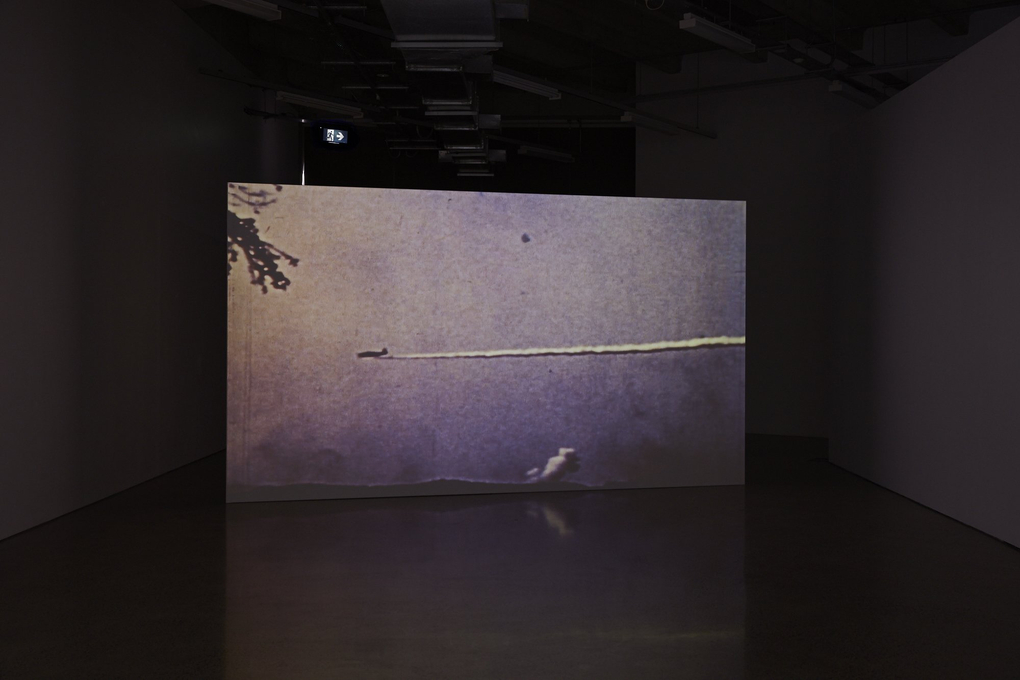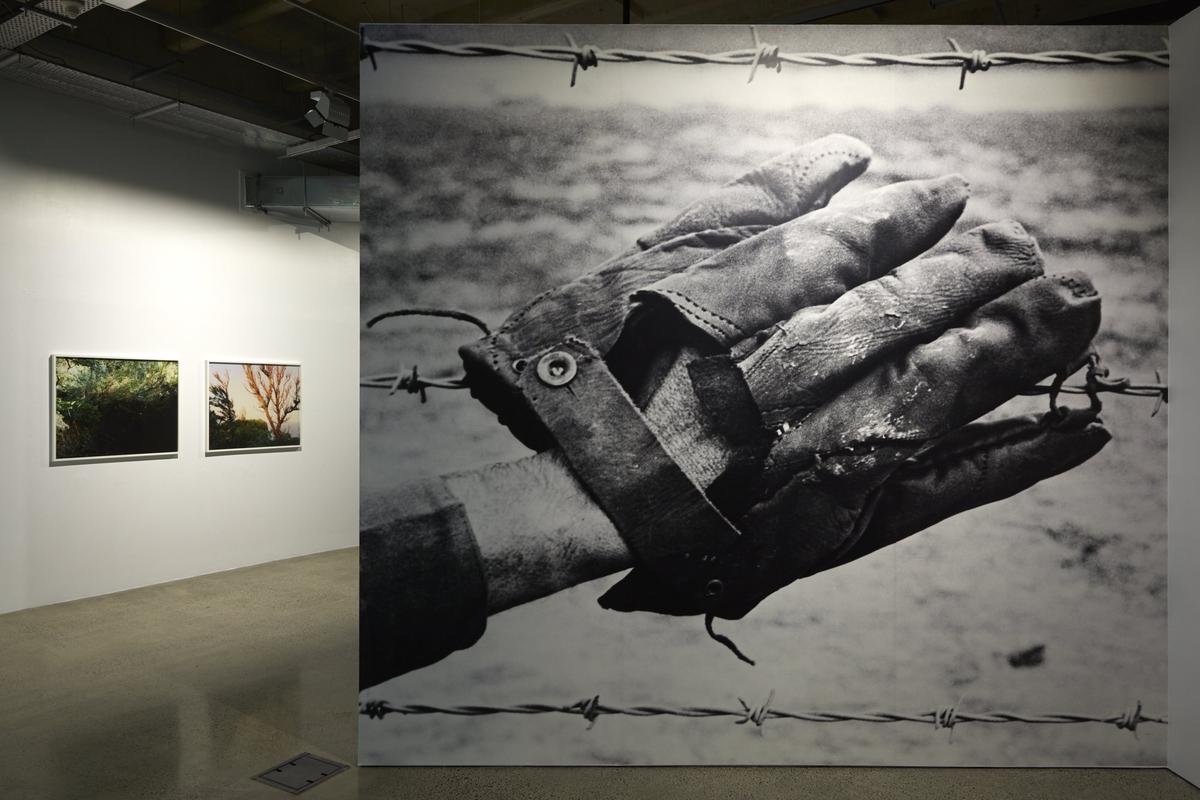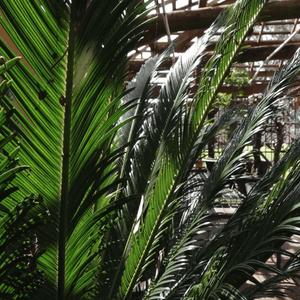Foliage, soil, silence. It Was a Cave Like This (2017-18) opens to the lens drawing a gentle, verdant line, bringing the viewer into the cool sensations of an undergrowth. A voice; “You helped do this.” “...You helped light this flame.”
The first of four moving image works included in the exhibition A Body that Lives, It Was a Cave Like This introduces the thematic concerns and structural sensibility that have shaped Amundsen’s recent documentary practice. Focusing on the lived aftermath of the Asia-Pacific War (WWII), each of the four image sequences included in A Body that Lives variously bring together declassified archival footage, witness testimonies and documentary footage shot on location in Okinawa, Pittsburgh and the Cowra Japanese Garden and Cultural Centre, to situate a mode of documentary image-making Amundsen positions as "visual listening."
In It Was a Cave Like This the lens creates an image-structure for the wartime remembering of Mrs Michiko Uehara. It holds us close to the soft grey of a cave surface as splayed roots move gently in the presence of the camera, cuts to blackout frames with subtitles and voice over, and moves in and out of archival sequences that appear as edited as much for their aural presence as for the visual material that they reproduce. This considered movement between image and sound sequence prioritises a body-to-body encounter with a process of remembering—between the body of the viewer and "body" of the image—a sensibility that is carefully elaborated across the exhibition. We are drawn toward the textures of place, affect and partial biography, and follow the trace of the war-time appartatus as it takes the shape of airplanes, smoke trails and flames. The image thus opens us to the inchoate physical force that the aural world and on screen action implies, without directly rendering what we know to be indexed; the unconscionable destruction of physical bodies and place.

Installation view of To Each Other/Way of Life (2016) Fiona Amundsen. One-channel HD video, 26 min 54 sec, in A Body that Lives, ST PAUL St Gallery, AUT, 28 September-26 October 2018. Photo: Sam Hartnett
In this way, the narrative structure ebbs away from the presentation of fact rendered as overwhelming and incoherent pain, toward a reflective quietude anchored in embodied memory and residual artifacts.
Amundsen’s approach cultivates a soft treatment of time, breaking with linearity and a call and response structure of interpretation between that which is imaged, and that which is carried by each voice. There is a sense of looping and return, and of omissions from the flows of onscreen conversation. Each work thus orbits the subtle matter of the context that it has entered into conversation with. Sequences of speech move between first-person recollection and intermittent conversation between the speaking witnesses, Amundsen, and her translators, blurring in and out of present, future and past tenses. As such, the recorded acts of remembering "listen" to pain, moving through and around memories, in such a way that might echo the complexity of our own experience of embodied time. Sensation and story-telling, incoherence and connection-attempts become the substance which carries the weight of each work.
This logic takes physical form in the very structure and design of the exhibition space. Three of the moving-image works are projected onto two large opaque screens—one in each of the larger galleries—enabling a reading of each image surface as a form of living body in itself. As a visitor to the exhibition, ones orientation takes shape in passage around both their front and back-facings and in the spill of light and movement that takes place on, as well as through, each screen. The installation is sparse, but deft, conjuring a reflective tone and syntax that takes shape between each of the moving-image works, framed photographs and photographic archival reproductions.
The title work of the exhibition, A Body That Lives (2017), is the only one of the four moving image sequences to reveal a visual recording of its speaking subject. In this piece, Amundsen and her translator interview Mr Teruo Murakami, a survivor of the 1944 "Cowra Breakout," when at least 1,104 Japanese prisoners of war attempted to escape from a prisoner of war camp near Cowra, in New South Wales, Australia, whose body moves in and out of a closely cropped frame. This is the most active of the four films—in the sense that the interviewer's interpellations into Mr Murakami’s process of recollection are both highly directive and audible—and we become witness to the physical negotiations of Murakami’s process of remembering, which in moments, signals a resistance to remembrance.
Mr Murakami is 96 years old, and his own process of remembering has evidently been shaped by the passage of time, moments of shared recollection and communion with other survivors, and the offical recounts of this historical tragedy. Amudsen via her translator attempts to negotiate this opacity, asking of Murakami that he access his experience of events by posing questions to him about the sounds he can remember hearing during the outbreak. This is a difficult moment for the viewer, as we bear witness to Mr Murakami encountering the limits of what he either can, or is willing to call back into consciousness. In a later sequence, an exchange passes:
Murakami: I am not really willing to remember
Translator: Is there a reason you don’t want to remember?
Murakami: No particular reason.
Reason or no, we are not summoned to these stories as detective-viewers in pursuit of truth. Rather, the work encourages a mode of engagement that is closer to that of attendant-listeners, in which the audience is invited to consider themselves as participants in an "alive, plural and evolving" conception of history. This is a subtle and affecting work, which nevertheless caused some discomfort for viewers when Amundsen initially presented it as a response to a 2017 CIRCUIT Commission intended for the cinema. To my mind, having seen the work in both settings, this work is much better served by being shown in the context of this exhibition, where not only the scale of the image surface is more intimate, but the architecture of Amundsen’s documentary ethics is more cleared articulated. In this setting, we can sit responsively with the work and feel out the punctuations, asymmetries and discontinuities of the body of work as a whole, as they play out gently across the three exhibition spaces.
A body that lives (excerpt) (2017) Fiona Amundsen. Commissioned by CIRCUIT with the support of Creative New Zealand
In Gallery Two the sequences To Each Other (2016) and Way of Life (2016) play as a single loop. Exhibited similarly at Artspace in 2017 for the documentary exhibition Ex-Ante, the two works attend to complex personal perspectives of the 1945 American aerial fire-bombing of Tokyo. In To Each Other we listen to Mrs Kayoko Ebina as she recounts the loss of her family during the 1945 aerial raid, while on-screen images move between wartime propaganda footage of steel production in the United States and present-day filming of a former blast furnace in Pittsburgh. In Way of Life, we listen to Japanese-American war veteran Ben Kuroki recount his experiences of war-time racial predjudice, and his role in the bombing as a pilot in the American airforce. Action and force are again foregrounded by the archival footage, bringing us once more into the physical machinations of the war-engine. The two partial testimonies however, rest on other physical textures and affects; the falling of tears (drip, drip, drip, in the English subtitles, heard simultaneously in spoken Japanese as poro, poro, poro), awareness of shame, the experience of racism, and an ephemeral gesture of memorialisation embodied in a bow.
The potential for documentary practice to enact alternative possibilities for memorialising, is the current that runs through each of these works. Drawing on Eve Kosofsky-Sedgwick’s notion of "reparative reading," Amundsen continues to pursue lens-based documentary as an ethical substrate for a reparative artistic practice. We might read the title of the exhibition, A Body that Lives, therefore, not as a direct reference to the figure of the film of the same title, or the endurance of any single individual. Rather, we might come to it as a mercurial reference to the body of the image, the body of history, and the social body that might be enacted through the embodied, intercultural forms of connection that such a lens-based practice of listening might give rise to.

